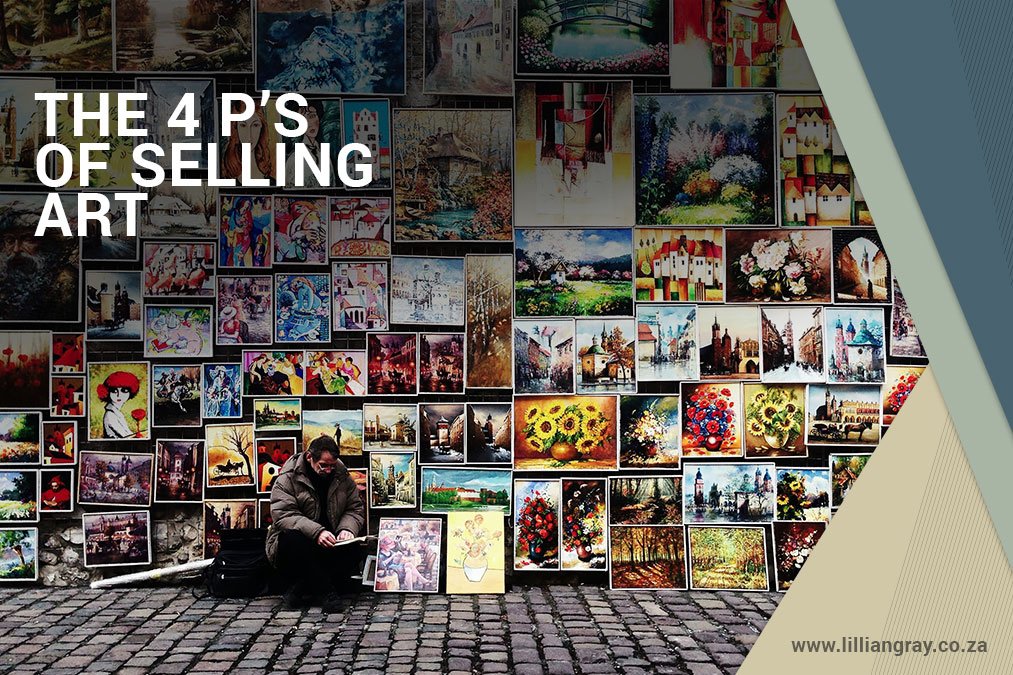No products in the basket.
Art Business Tips
Surefire success: The 4 P’s of Selling Art
These 4 P’s a helpful little checklist to see if your art marketing is working.
Most artist’s don’t enjoy marketing or selling. They tend to shy away from the business side of things. This is such a vital skill for us as artists to master, especially if you don’t want to die alone with an attic overflowing of the art you never sold. So let’s get good at marketing and selling our art.
I love business and art and completely believe in Andy Warhol’s statement that
“Business is Art and Art is Business.”
In my current journey, I am preparing for 3 international Art Exhibitions. So I thought it would be great to brush up on my Marketing Skills in preparation for these events.
In my search, I came across The 4 P’s of Selling, from the Social Triggers podcast by Mike Del Ponte. The 4 P’s are used widely in marketing.
In this blog post, however, I want to teach you how to apply them to selling your artwork.
1/ PROMISE
The first P is your promise to the client. This is usually the opening statement of your marketing material or video. You have 5 seconds to keep the viewer’s attention in a video and 3 seconds to keep them on your website. This needs to be catchy.
What is your promise to the client as an artist?
For me, it is “Own an original Lillian Gray painting.” In this statement, I am promising that the artwork is an original idea or image. The statement also hints at the fact that it is investment art. There is value in the brand name “Lillian Gray”
2/ PICTURE
This P is about creating a picture for the client. When you try and sell a pen, don’t start by listing all the characteristics of the pen. “It has fibre tip, firm grip, etc” You will lose the client. Instead, create a visual picture for the client.
“What would it look like if you need to sign an important contract and you take out an old Bic pen with a chewed end? What impression would that create? Would your client be impressed? Now imagine taking out a German Manufactured pen with a beautiful matt black casing? What impression would that create?”
You have now created an image for the client of what it would be like to own this pen. Many people would object to this idea by saying isn’t it better to sell the benefits of the product first? However, this isn’t true. Focus on the emotion and not the functionality.
People buy with their emotions and then justify it with logic.
How can you create this picture for people to buy your art?
3/ PROOF
The 3rd P is Proof. Show don’t tell. Don’t tell them this is great investment art – show them. Show the collectors that have bought your paintings. Don’t tell them you are a rising artist, show them the list of exhibitions you have attended. Don’t tell them they are buying a piece of high-quality art. Flip your canvas around and show them the Belgian weaved canvas. Draw their attention to the thick oil paint your use. Show the rough textures of the brush sweeping across the canvas. Don’t tell them it would look great in their house. Show off photos of your artworks hanging in beautiful foyers or bedrooms. Embed your artworks into a stunning interior.
4/ PITCH
The 4th P is Pitch. Most people in selling focus 80% of their time and effort on this last P, but forget about the first 3. This then becomes pushy marketing. However, without this last P, the entire marketing effort is useless. If the action you want the client to take at the end is unclear, they will do nothing.
The more options you give a client the less they will buy. End with one thing you would like them to do at the end of your sales pitch. Only one call to action.
When I still owned my own design agency I use to chant to my sales team “A confused mind doesn’t buy.”
So don’t confuse your clients, guide them.
I am text block. Click edit button to change this text. Lorem ipsum dolor sit amet, consectetur adipiscing elit. Ut elit tellus, luctus nec ullamcorper mattis, pulvinar dapibus leo.
So these are the 4 P’s Promise, Picture, Proof, Pitch. I hope these are helpful to you and that you are up for the challenge in applying them to your own artworks.



